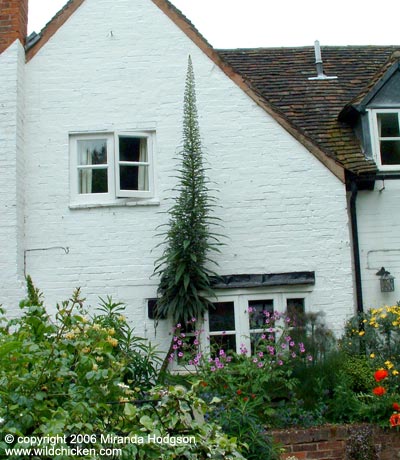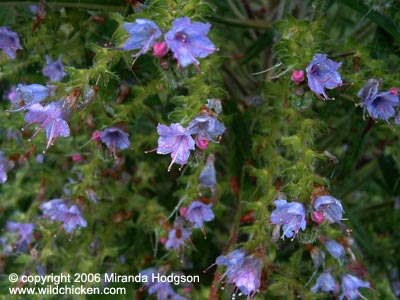


Echium pininana (also called Tree Echium)
Echium
pininana
Half-hardy biennial/triennial, native to the Canary Islands. In its first year, Echium pininana does little more than put out a large rosette of bristly leaves. In its second, or third, year, however, it sends up a thick, fast growing, tapering stem, up to 4m (just over 13 feet) high, thickly clothed with green leaves and thousands of small blue flowers. If it has support and shelter, it can be very impressive, the talk of the neighbourhood even.
Echium pininana is said to grow best in the UK in a southern maritime situation, but the plant in the top photo was grown in a village near Solihull, in the centre of England - not exactly maritime. Unfortunately, it blew down in a late summer gale, but at least it had flowered well before then. I've also seen Echium pininana growing as far north as East Yorkshire, at Burton Agnes Hall, although it was in a very sheltered part of the garden. I'd say that if you have free draining soil, and somewhere sunny and sheltered to grow it, it's worth a go.
Very attractive to bees and hoverflies.
Summer and autumn.
Habit - upright, may need some support. H: up to 4m S: up to 1m.
Stem - rounded, tough, bristly, buff-pale green.
Leaves - ovate, hairy to bristly, mid-green, pronounced veining, smooth edged.
Flowers - roughly bell-shaped with lobed tips. Pink buds open to flowers that are blue, tinged with purple; pink stamens, marked with white or blue at the tip.
Sun and shelter is essential.
Well drained, light. Dislikes wet clay.
Half hardy in the UK - needs all the sun and shelter it can get.
Little needed, as this plant traditionally grows in poor soil, though you may need to dig in grit if you are on a clay soil. Will probably need support. Protect the crown from excess wet in winter or it may rot off.
The stems and leaves are quite bristly, so you may want to wear gloves if you handle it, especially when removing the plant once it has died and dried out a bit.
Collect seed in autumn after flowering and sow indoors from late winter to spring. Will self-seed.
Garden Plant Information list of plant care info by botanical name